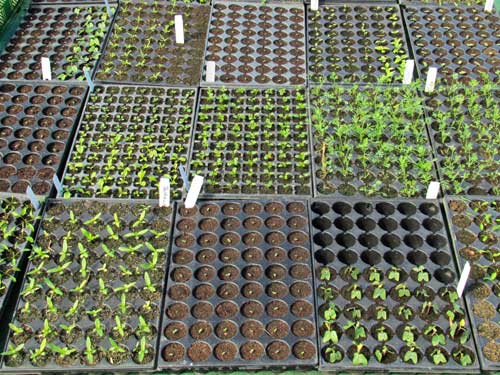What is nutrient conditioning?
Nutrient conditioning is the process of managing the nutrient content of seedlings in the nursery for optimal growth when they are transplanted. This sounds easy, but good growers achieve higher yields with the same variety because they understand how to manage it correctly.
We all know that plants need adequate levels of nitrogen, phosphorus, potassium, calcium etc. for optimal growth. Here is the problem, most seedling growth mixes are inert within the growth period in the seedling tray. The growth material does not really decompose and provide a significant portion of the nutrients. So the nutrient content of the most commercial growth media is low. So, the frequency and composition of nutrients applied through the irrigation system (nutrient solution) will determine the seedling nutrition.
Successful commercial growers keep the nutrient solution between 100-400 ppm. That is because the seedlings growth rate is optimal within this range. As soon as the concentration is outside this range the growth rate decreases, or put it simply, your yield will be lower. Levels must be kept within this range. You cannot apply nutrients will-and-nilly with the hope of good results. A grower can easily apply too high nitrogen levels (although not toxic) that will reduce the survival rate of the seedling when transplanted. It is important to note that not all nutrients have a high effect on growth rate. For instance, phosphorus has a less marked increase in plant growth than nitrogen. The ideal phosphorus concentrations are between 15-60 ppm. Potassium can be between 10-250 ppm with no significant loss in growth rate. Remember, potassium is highly mobile and more than 90% will be leached out before the plant and absorb it.
So the most important nutrient to control and manage is nitrogen. There are two approaches:
1. Low levels of nutrients throughout the growth period of the seedling and increase nitrogen just before transplanting.
2. Provide optimum nutrients throughout the growth season and a week before transplanting, reduce it to the minimum
The first method has the disadvantage that the seedlings growth period can be very long. Almost all growers use the second method since it provides the shortest growth time.
Never ignore micronutrients, especially iron (Fe) and molybdenum (Mo). The plant always needs micronutrients but in very small quantities. The seedling does not need micronutrients every day as with the macronutrients. This is because the growth medium absorbs enough micronutrients for the plant to grow optimally.
So, nutrient conditioning is controlling mostly nitrogen during the initial stages of the vegetable seedling so that optimal growth can commence as quick as possible in the greenhouse. Always measure the nutrient content of the runoff water in the nursery to ensure that the N concentration is not lower than 100 ppm or above 400 ppm.




Thank you. Can you write an article on diy nutrients for tomatoes and vegetables in Dutch buckets and ebb and flow system?
Hi. If you want DIY solutions for vegetables you can read the following articles that I wrote on this site:
Growers usually start of with:
https://www.commercial-hydroponic-farming.com/how-to-formulate-a-nutrient-solution-with-complex-fertilizers/
Then more advanced mixing:
https://www.commercial-hydroponic-farming.com/nutrient-stock-solutions-hydroponic-systems/
https://www.commercial-hydroponic-farming.com/macro-hydroponic-nutrient-solution-formulation/
https://www.commercial-hydroponic-farming.com/hydroponic-micro-nutrients-solution-formulation/
Then you can move on the the following articles:
https://www.commercial-hydroponic-farming.com/fertilizer-solubility-nutrient-stock-solutions/
https://www.commercial-hydroponic-farming.com/specific-gravity-liquid-fertilizer-adjustment/
https://www.commercial-hydroponic-farming.com/what-everybody-ought-to-know-about-milli-equivalents-me-and-parts-per-million-ppm/